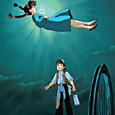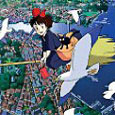Chaman Productions/Studio Canal/TVA International/Sony Pictures (January 1, 2003), Columbia Tri-Star Home Entertainment (September 7, 2004), single disc, 91 mins plus supplements, 1.85:1 anamorphic widescreen (Canadian version has 1.85:1 letterboxed widescreen), Dolby Digital 5.1 (Canadian version has Dolby Digital 2.0 Surround), Rated PG-13, Retail: $24.96
Storyboard:
A young woman on a distant world discovers an ancient truth about her people.
The Sweatbox Review:
The CGI revolution is in full swing in the U.S., but it is not only an American phenomenon. While Japan continues to embrace traditionally drawn animation, Europe has begun to produce some computer-animated features, and the first one out of the gate was Kaena: The Prophecy. This 2003 French film has some familiar themes, but also utilizes an impressive production design to tell its story of a girl who just may prove to be a savior to her people.

The story takes place on a distant world. Hundreds of years ago, a spaceship landed and most of the crew was lost. In the present, a tribe of humans has developed, but they are just barely surviving. They gather “sap” from their environment, and try to please their “gods”. A girl named Kaena is the freest of thinkers among her people, and is more interested in exploring than working. She also challenges the word of their high priest, showing a level of defiance that astounds the others. She knows that there is more to their world than what most have seen, and she is determined to find what secrets may lie beyond the known. Her suspicions of a greater world seem to be confirmed when she finds an ancient metal relic after escaping from a monster. The only one she can discuss this with is a heretic long banished, named Ilpo. Ilpo knows something of the “outside world”, but is hesitant to discuss it. He also seems a little nuts.

Meanwhile, two oily-looking native creatures discuss how their world is dying due to being attacked, assumedly by the actions of the humans. There is obviously an antagonistic relationship here, even though the humans are unaware of it. A third set of players involves the lone survivor of the crash 600 years ago and his assistants, who are essentially cyborg worms. Naturally, Kaena’s destiny lies in her interaction with the alien, who holds the secrets of her people’s origins. But there is an even more dangerous secret that may alter the destiny of the whole planet. By the time the three groups have their final clash, nothing will ever be the same.
This is a story of mystery and high adventure, large in ambition if falling a little short on execution. There is a strong attempt at myth making, but the haziness of the storytelling proves detrimental. When the secrets of Kaena’s world are explained, there is a feeling of, “Huh? What was that again?” And the resolution of the story, concerning the various fates of the characters and the world, proves to be unsatisfying since a couple of questions are left unresolved. Nevertheless, it can be a fun ride.
I viewed the Canadian version of this DVD, which has a more subdued cover than the U.S. edition. The elegant menu gives the French title of Kaena: La Prophetie, and gives the viewer the option of proceeding to either French or English menus. As this is a French film, the credits are in French. When the movie opens, the graphics look to be on par with the best that Hollywood has to offer, right up there with the most recent sci-fi blockbusters… until the characters appear.

In their defense, the artists behind Kaena were not attempting to create totally realistic humanoids, and allowed them still look like the cartoon characters they are. Their eyes are big, and their other features a bit exaggerated (especially Kaena’s figure), making the humans look something like Thunderbirds puppets. The puppet analogy is made all the more strong by the frankly stilted animation (think Reboot) and the smoothness of the peoples’ features.
The spectacular vistas and numerous fantastic creatures are a wonder to behold, and to be honest the visuals were enough to hold my interest. Yes, I’m an “eye candy” kind of guy. There is a lack of clutter that seems to be in direct contrast to the recent Star Wars films, allowing the visuals to breathe. In terms of creating a fantasy world, I was reminded of Jim Henson’s masterpiece The Dark Crystal, for which Brian Froud designed a believable but totally alien environment, including unique flora and fauna. Kaena is not quite so rich as The Dark Crystal, but neither does it suffer greatly by comparison.
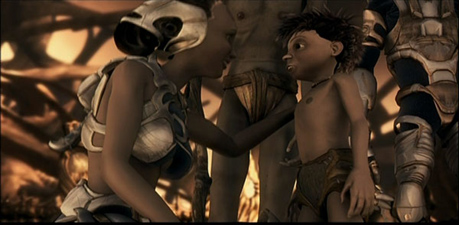
It is probably a good thing that the visuals entranced me, because otherwise I may have had trouble making it through the movie. While I did enjoy it overall, the plot does tend to be overly elusive at times, and I confess that some explanations regarding the mysteries in the story left me a little confused, as did the ending. There are two schools of thought here: either the material is “challenging”, or it is just plainly a result of poor storytelling. I guess it depends on how much you enjoyed the telling of the tale, and what your tolerance level is for figuring out that which is not fully explained.
Other nitpicks would include such clichés as Kaena being an orphan, the challenging of the notion of “gods” in the story, the “lone survivor” angle, and the orphan’s struggle to provide the truth for her people. I found all this forgivable, though. What was more distracting were a couple of movie pastiches, such as a “Ripley/Alien” moment. It was undoubtedly meant to be a tribute, as it is too obvious to be considered a cheap rip-off, but I find such shenanigans distracting and they take me out of the story.
Canadian viewers should be aware that a batch of the DVDs for sale in Canada had a problem with the second layer, rendering the last third of the movie unwatchable. If you get a copy, check it by going to one of the later chapters to make sure it is working. My first copy had this problem, but my next copy was fine.
Is This Thing Loaded?
The 2002 Le Making Of featurette (yes, that is what it says; French linguists must be up in arms) runs 14 minutes, and has plenty of interview footage with the creators, as well as some glimpses of production artwork and animation-in-progress. Unfortunately, it is all in French— no subtitles. Considering how much of the footage is of the “talking head” variety, this is a big detriment to non-French speaking viewers. Well, it looked like everyone had interesting things to say. (Perhaps the U.S. disc received subtitles?)
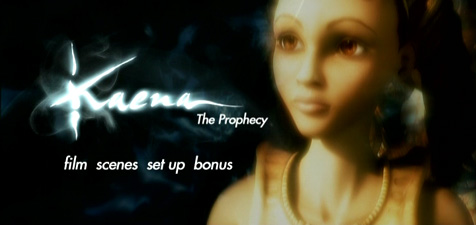
The Virtual Interview (3:25) features the digital “actress” who played Kaena in an on-set interview. This one is also presented in French, but this time English subtitles are provided. It is actually a cute little interview, one of the better ones I have seen of this type. The character animation is surprisingly better than in the feature, as the endearing “actress” is allowed to show a wider range of emotions than was called for in the movie itself. Maybe the sequel should focus more on this “actress” than Kaena.

(The Sony U.S. release has the same extras, plus some previews for other CTS DVDs.)
Case Study:
Standard keepcase. The U.S. cover has more up-front imagery, while the Canadian cover is more subdued.
Ink And Paint:
After watching the movie, I realized that I had not written down anything about the video presentation. That’s because the video was flawless. I noticed no instances of shimmering, aliasing, or other artifacts. Either the print was without any blemishes, or this was a digital-to-digital transfer.

The letterboxed 1.85:1 image is presented without anamorphic enhancement on my Canadian edition, but was extremely vibrant even when zoomed on my widescreen set. I could simply not be more satisfied with the video presentation. Outstanding. (Note: The U.S. version, from Sony Pictures, apparently had an anamorphic transfer.)
Scratch Tracks:
Audio selections include either French or English 2.0 tracks. They are very similar in regards to quality. In either case, the sound design is extremely full and rich, right up there with decent 5.1 mixes. I greatly appreciated the enveloping effect of the sound design, and congratulate the people behind the sound for doing so much with a 2.0 mix. In fact, this may be the most ambient 2.0 sound ever. There are no subtitles available, so you will likely wish to go with the English track, featuring voices by Kirsten Dunst, Angelica Huston and Richard Harris, whose performances are quite good. The animation actually syncs best with the English track, so I suspect that this was by design in recognition of the greater English-language market. Further lending credence to this notion is the English-language song at the end of the movie (even on the French track). (Note: Sony’s U.S. disc has a 5.1 track.)
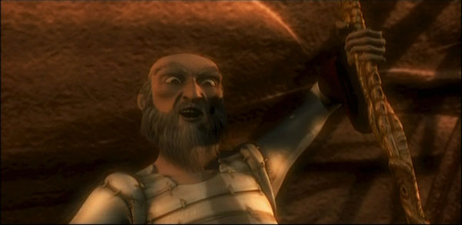
There is one point where the “worm” creatures in the movie speak their own language, and burnt-in French subtitles appear, leaving English viewers in the dark. Fortunately, the “worms” soon switch to English. I do not think I missed much, but it still would have been nice to know what was being said.
The music by Farid Russlan is somewhat gothic sounding and sets a somber mood. As soon as the score starts, one is inclined to take the proceedings seriously.
Final Cut:
While not having a groundbreaking storyline, and the animation is not as lifelike as some of the current American productions, Kaena nevertheless packs plenty of visual punch and boasts an interesting premise. The production design is stunning, from the conception of the creatures to the beauty of the uncluttered environments with their unique earthy color schemes. The plot leaves itself open to debate, since story points are not as clear as they could be, and sometimes outright confusing, but viewers who do not mind filling in the gaps themselves may not mind.
I found this movie worthwhile due to some beautiful design work, but the cloudiness of the plot admittedly left me feeling a little cooler. With mixed feelings, I recommend this one for those who are curious about the state of the art in French CGI animation. For those wanting an anamorphic transfer and full 5.1 sound, the U.S. version is the best bet, although I do prefer the Canadian version’s cover art.
 | ||
 |







